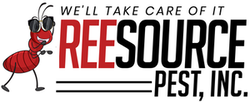In this region, the main species of termites found is Eastern subterranean termites (Reticulitermes flavipes). This cryptic wood-destroying insect is usually not found until the colony infesting a building has reached maturity and sends out large swarms of alates (swarmers). This usually occurs starting mid-spring through the summer and sometimes into the early fall. Termite swarms can happen inside in large numbers. They are harmless to staff and the public and are primarily a nuisance. Swarms usually only last a day or two before the swarm has been completed.
The technician, in response to a swarm, would first make a positive identification of the swarmers. Ants nesting on or in the building are also capable of producing similar looking swarms and swarmers. The differences between the two are easily determined by looking at the wings of specimens collected. The technician would use a HEPA vacuum to remove them and then identify the location from which they emerged. If the site where they emerged inside is found, the technician may exclude it using caulking to help prevent any subsequent swarms that may occur.
The technician would then inspect to see if termites are infesting wooden items inside. This is usually found by finding the presence of shelter tubes made of soil carried in by termite workers and constructed to protect themselves by regulating the moisture within the tubes. If termite damage is found, the technician would complete a graph drawing depicting where the damage is in relation to the exterior of the building and showing what conditions are conducive such as excessive moisture accumulating against the building. Eastern subterranean termites nest in the soil outside of buildings and need a lot of moisture to survive and to keep from readily desiccating.
Chemical action: Insecticide applications are needed to control termites. Liquid insecticide soil treatments are made down into the soil against the building using a termite rig to pump the liquid. The most common and effective liquid treatments performed today involve the use of non-repellant liquid residual termiticides that the termites would cross through undetected by them and pick it up on their bodies. When they return to the nest, they would transfer the active ingredient to the other termites in the colony and soon the entire colony is eliminated.
